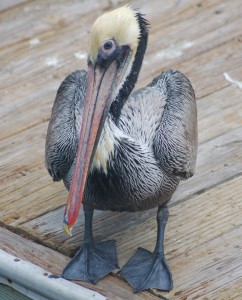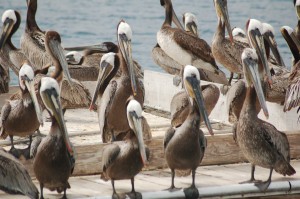
Photo credit: Bobbie Hedges
Taking a walk along the Redondo pier is a great way to enjoy the fresh ocean air mixed with fishy aromas while checking out the natural art gallery just across the way or painted rocks as we like to joke during whale watch season. And in this case the featured artist is the California Brown Pelican or Pelecanus occidentalis californicus, the largest seabird in Southern California with a wingspan of more than six feet.
The break wall rocks are splattered in a modern art sort of way, with large patches of white at the top dripping down as if intended by an artist who threw paint at the wall and allowed gravity to determine the final masterpiece. But in this case the paint is guano or seabird excrement. This natural art smells really bad and during whale watch season I hold my breath as we glide by while admiring the artists and their strange antics.
Pelicans are part of the family Pelecanidae, the name bestowed upon birds who share the characteristic of having a totipalmate foot and a gular pouch. This fancy named foot really just means that all four toes are connected by a web of skin, even the odd hind toe. And thanks to these special feet the pelicans and their brethren swim well, but walk poorly.
The pelican seems stuck in time with its prehistoric looks, huge bill and large wings, reminding me of drawings of the pterodactyl, the winged reptile of a bygone era. Young brown pelicans have mostly brown feathers, but adult males and females look the same and change plumage around their annual breeding cycle.
According to an article by pelican researcher Mark Shields in the The Birds of North America Online database, just before breeding season begins males and females have yellowish feathers on their head and dark brown feathers on the neck. Once breeding season is in full swing the head feathers turn white while the neck feathers remain brown and after breeding season is over the head returns to yellow while the neck feathers turn white. This rotating color scheme is a bit confusing to remember, so if it throws your brain into overdrive focus instead on remembering fun facts about the gular pouch, which turns bright red during breeding season.
The gular pouch is the stretchy sac looking device forming the bottom beak and serves as a built in fishing net. According to The Sibley Guide to Bird Life and Behavior, the brown pelican is known for its preferred method of food gathering: plunge-diving. From as high as 65 feet, the California Brown Pelican steeply dives, plunging into the ocean to catch fish. The head never wobbles allowing the pelican to maintain eye contact with its prey, just like a top batter never takes his eyes off the ball.
Once the pelican hits the water the bill opens to snag dinner and the gular pouch expands with the capacity to hold close to three gallons of water if necessary to capture fish. The water drains out at a leisurely pace while fish remain trapped inside.
In order to keep the gular pouch in tip top shape, pelicans do yoga moves to maintain flexibility. One common exercise is the longitudinal stretch where the pelican tips the head all the way back pointing its beak to the sky giving the gular pouch a nice vertical extension.
While providing regular maintenance tune-ups to the gular pouch, pelicans have not figured out how to install low-jack security making them vulnerable to kleptoparasitism. Yes, this is a real word. It means one animal steals food from another, just as a parasite benefits at the expense of the host only this version involves thievery.
According to Shield’s article, a gull will land on or hover by the pelican’s head and while the pelican waits for excess water to drain from the gular pouch the gull will snatch its dinner, usually sardines or anchovies, and take off. This makes the gull a kelptoparasite and an unwelcome dinner guest. You know the type who somehow always forgets their wallet plus eats all the appetizers and your dinner too. Not cool.

Photo credit: Bobbie Hedges
Despite being prone to pilfering, the gular pouch is not to be underestimated and plays a role as males try to woo females. Instead of saying, “May I buy you a drink?” the male publicizes he is looking by swaying his head from side to side. “In head swaying, the motion of the pelican’s head and bill is in the shape of the symbol for infinity,” said Shields.
Once he has a female’s attention, the male begins gathering nesting materials and stages what Shield’s article refers to as “nest material presentation display.” The male then proceeds to do the following: “spreads wings, holds bill nearly horizontally, distends gular pouch, and holds nest material about one-third length from tip of bill.”
If this move is successful, the female responds by swaying her head from side to side in a similar pattern and then takes the nesting material from the male’s bill.
Now this is where things get interesting. Instead of waiting for the nest to be built, they start having sex in the middle of the construction site. So while floors are being installed and walls are going up, they’re doing it. This process makes for two mutual activities, mutual sex and mutual construction.
Shields explains that the “female builds [the] nest using material gathered by [the] male, who supplies progressively smaller sticks as construction continues.” This process takes about seven to 10 days, and possibly ends when the nest is complete or the smallest possible stick has been found and it’s time to move on.
Typically, female pelicans lay three eggs. But instead of using their breasts to keep the eggs warm, pelicans use their feet. This is best described by Allaboutbirds.org, “They hold the eggs under the webs that stretch from the front toes to the hind toe, essentially standing on the eggs to warm them.”
The totipalmate feet incubate the eggs! This seems incredibly uncomfortable and impractical, squatting on the next generation all day. For the most part this strategy works well for pelicans, except of course when humans enter the equation.
During the late 1950s to the early 1970s, the California Brown Pelican nearly disappeared thanks to pesticides that polluted the marine environment. According to Dr. Daniel Anderson at UC-Davis who has researched California Brown Pelicans extensively, DDT caused major problems for our pelicans that live locally in the Southern California Bight.
“A normal 4,000-6,000, perhaps more, historical data are not precise, breeding pairs were reduced in one year to just 200 pairs and it held at very low numbers for a number of years,” said Anderson. That’s terrible!
Anderson explained that DDT converts to a molecule in the environment that causes eggshell thinning. While DDT caused problems for many birds, the pelican’s choice of using their feet for warming caused many pelicans to accidentally crack the eggs. This stepping strategy became a major problem in a short amount of time.
Thankfully, once DDT was removed in 1971, populations slowly recovered and now they are back to historical numbers said Anderson.
So take a walk down to the pier and check out the California Brown Pelicans loafing on the rocks. These recovered artists will be painting, stretching and socializing. Just remember to hold your breath if you get really close.
Informative, fun and irreverent. Really enjoy the thorough research and the unique spin that draws us in!
great post as usual!